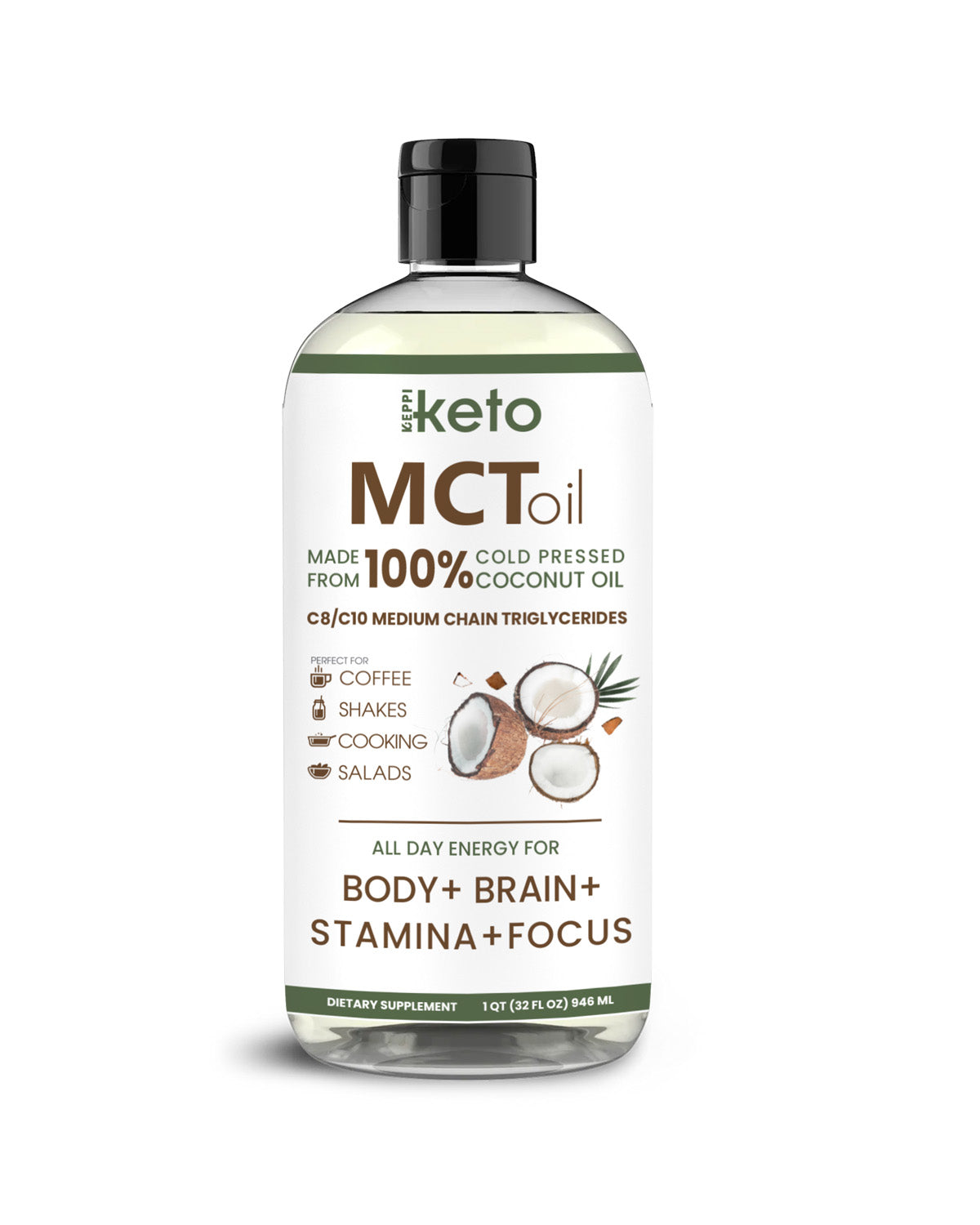
MCT Oil for Hair: What C8/C10 Really Do for Shine, Breakage, and Scalp Health
Share
Keywords: MCT oil for hair, C8 MCT, C10 MCT, coconut-derived MCT oil, caprylic capric triglyceride, keto coffee, ketone energy, hair growth, scalp health, reduce breakage, shine, lightweight hair oil, clean beauty, non-GMO, fractionated coconut oil.
When Hair Breakage Meets MCT Oil Doubts
You feel every strand that snaps in the shower, yet shampoo swaps rarely fix the pain point. The real challenge often hides inside your nutrition and leave-in routine—where medium-chain triglyceride (MCT) oil enters the conversation. Quick to metabolize and popular in keto coffee, MCTs offer clean energy; but whether that perk supports thicker, shinier hair requires a look at the evidence and smart application (Bach & Babayan, 1982; Cosmetic Ingredient Review, 2020).
In the overview ahead, you’ll see the science behind MCTs, best-practice application methods, and signs that indicate success or irritation. By the end, you’ll be able to weigh potential benefits against budget and routine using clear, research-informed criteria.
What You'll Learn about Is MCT oil good for hair?
- Key fatty acids and nutrient profile (C8, C10, C12)
- How MCTs may support scalp comfort and barrier function
- Warning signs of dryness or redness and how to patch-test
- Best practices for oral and topical use
- Easy at-home quality checks (sourcing, packaging, storage)
Quick Take: Does MCT Oil Benefit Hair Health?
Coconut-derived MCT oil (C8/C10) is a lightweight emollient that can smooth cuticles, reduce friction, and support scalp comfort—helpful for shine and breakage control when used correctly (CIR, 2020). Internally, MCTs are rapidly oxidized for energy, but direct evidence for hair growth is limited; treat MCTs as a supportive hair care tool, not a cure (Bach & Babayan, 1982; Rele & Mohile, 2003).
Learn more about Keppi C8–C10 MCT OilWhat Are the Best Education Topics Related to “Is MCT oil good for hair?”
- Fatty Acid Profile: C8 (caprylic), C10 (capric), C12 (lauric) explained
- Scalp Penetration & Barrier Support: emolliency and transepidermal water loss (TEWL)
- Oral MCT Use: energy & metabolic context for overall hair care
- Risk Factors & Safety: irritation, patch testing, storage
- Quality & Sourcing: coconut-only, fractionation, third-party testing
Fatty Acid Profile + How it Relates to Hair Care
You’ll see caprylic (C8) and capric (C10) acids on most MCT labels; some products include smaller amounts of lauric acid (C12). Shorter chains are low-viscosity and spread easily, helping reduce combing friction and protecting shine (CIR, 2020). By contrast, heavier long-chain oils can feel greasy or weigh fine hair down.
- C8/C10: lightweight, fast-absorbing emollients for slip and shine (CIR, 2020).
- C12: lauric acid shows scalp-relevant antimicrobial activity in vitro (Desbois & Smith, 2010) and coconut oil reduces hair protein loss vs. mineral oil in vivo (Rele & Mohile, 2003).
- Low viscosity helps reduce mechanical breakage during brushing (Rele & Mohile, 2003).

Scalp Penetration Science + Barrier Support
Caprylic/capric triglyceride (cosmetic-grade MCT) is widely used as a non-sensitizing emollient that softens skin and can help reduce TEWL when used in properly formulated products (CIR, 2020). A calmer, better-hydrated scalp is less prone to flaking and itch, creating conditions friendlier to healthy-looking hair. For direct hair fiber protection, coconut oil (rich in lauric acid) has the most specific evidence to date for reducing protein loss (Rele & Mohile, 2003).
- Light texture spreads evenly without heavy residue (CIR, 2020).
- Emollients can support scalp comfort and moisture balance (CIR, 2020).
- Coconut oil shows hair-fiber protein-loss reduction vs. mineral/sunflower oils (Rele & Mohile, 2003).
“Caprylic/capric triglyceride is a well-tolerated cosmetic emollient used to improve spreadability and reduce water loss from skin when properly formulated.”
Oral MCT Use + Whole-Body Context
When consumed, MCTs are absorbed rapidly and routed via the portal vein to the liver for quick oxidation—useful as clean energy but not a proven stand-alone solution for hair growth (Bach & Babayan, 1982; St-Onge & Jones, 2002). If oral MCTs help you maintain steadier energy and dietary adherence, that broader wellness context may indirectly support haircare habits (adequate protein, micronutrients, sleep) that matter for stronger-looking hair.
- Start at 1 tsp and build slowly to 1–2 Tbsp/day to limit GI discomfort (St-Onge & Jones, 2002).
- Pair with sufficient protein, iron, zinc, and overall balanced nutrition for hair structure support (Almohanna et al., 2019).
- Consider MCTs a supportive tool; set realistic expectations (evidence for growth is limited).
Risk Factors and Safety Checks
Every oil can irritate some users. Perform a patch test (inner arm, 24–48 h). For scalp use, apply a pea-sized amount first and observe.
- Stop use if redness, burning, or flaking worsens (CIR, 2020).
- Speak with your clinician if you manage liver or fat-malabsorption conditions (St-Onge & Jones, 2002).
- Store capped, away from heat and light to limit oxidation (CIR, 2020).
Quality, Sourcing, and Storage
Purity drives performance and skin feel. Look for coconut-only sourcing (not palm), gentle fractionation, and third-party testing. Glass or high-quality food-grade packaging helps protect stability (CIR, 2020).
- Request Certificates of Analysis for contaminants and identity when available.
- Prefer amber glass; avoid prolonged heat exposure.
- Use within 6–12 months of opening for best freshness.
Targeted MCT Fix for Smoother, Shinier Hair
If your strands feel brittle and dull, a C8–C10 MCT oil can act as a lightweight finishing oil to reduce friction and boost shine—without heavy buildup. For internal use, a slow-and-steady approach supports comfort while you focus on the fundamentals (protein, micronutrients, sleep) that underpin hair health (Almohanna et al., 2019).
Implementation Process: Step-by-Step Path to Results
- Warm ½ tsp between palms; massage gently into the scalp for ~2 minutes.
- Smooth any remainder through mid-lengths and ends; wait 15–20 minutes.
- Shampoo lightly; condition to maintain slip.
- Optionally, add 1 tsp MCT oil to coffee or a smoothie 3×/week; increase only as tolerated (St-Onge & Jones, 2002).
MCT Oil: The Fast Fuel for Hair Routine & Daily Energy

Keppi C8–C10 MCT Oil
Sourced from non-GMO coconuts, Keppi’s C8/C10 MCT Oil is a flavorless, fast-absorbing emollient for hair finishing and a clean energy source for daily routines. Produced in GMP-compliant facilities and batch-tested for quality.
Why This Methodology Can Help
- Low-viscosity emolliency improves slip and surface gloss without heaviness (CIR, 2020).
- Coconut-oil data shows reduced hair protein loss versus mineral/sunflower oils (Rele & Mohile, 2003).
- Clean, coconut-only sourcing aligns with clean beauty and scalp-first routines.
Conclusion
Bottom line: MCT oil (C8/C10) is a useful haircare emollient for shine and slip, and a convenient nutrition tool for clean energy. Evidence for direct hair growth is limited; however, pairing topical MCT with good nutrition, adequate protein, and stress/sleep management creates a practical, science-aware routine (Almohanna et al., 2019; CIR, 2020). Start small, patch-test, and prioritize quality.
Take Control of Your Hair & Wellness
Ready for smoother, healthier-looking hair and steadier energy? Learn how Keppi C8–C10 MCT Oil fits your routine.
Learn MoreReferences
- Almohanna, H.M., Ahmed, A.A., Tsatalis, J.P. & Tosti, A. (2019) The role of vitamins and minerals in hair loss: a review. Dermatology and Therapy, 9, 51–70.
- Bach, A.C. & Babayan, V.K. (1982) Medium-chain triglycerides: an update. American Journal of Clinical Nutrition, 36(5), 950–962.
- Cosmetic Ingredient Review (2020) Safety Assessment of Triglycerides as Used in Cosmetics (incl. Caprylic/Capric Triglyceride). CIR Final Report.
- Desbois, A.P. & Smith, V.J. (2010) Antibacterial free fatty acids: activities, mechanisms and structure–activity relationships. Applied Microbiology and Biotechnology, 85, 1629–1642.
- Rele, A.S. & Mohile, R.B. (2003) Effect of mineral oil, sunflower oil, and coconut oil on prevention of hair damage. Journal of Cosmetic Science, 54(2), 175–192.
- St-Onge, M.P. & Jones, P.J. (2002) Physiological effects of medium-chain triglycerides: potential agents in the prevention of obesity. Journal of Nutrition, 132(3), 329–332.
